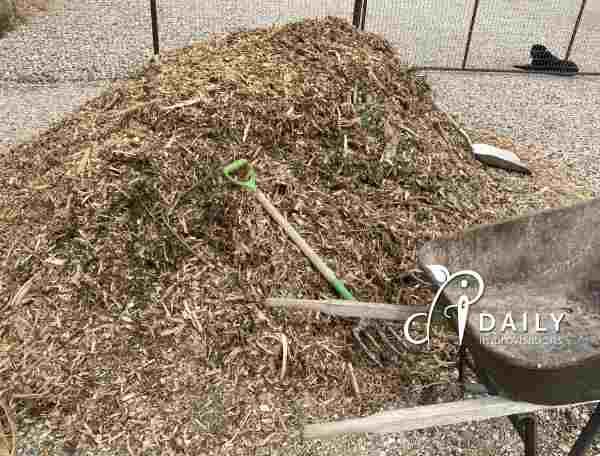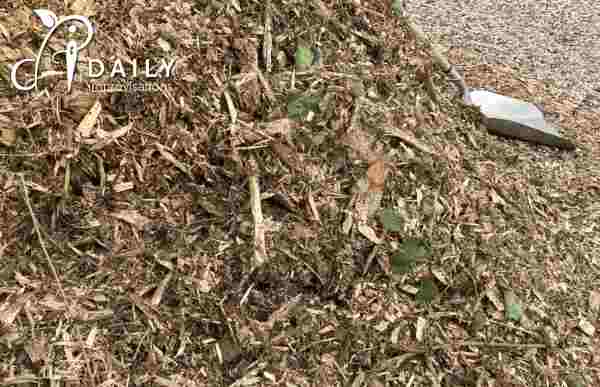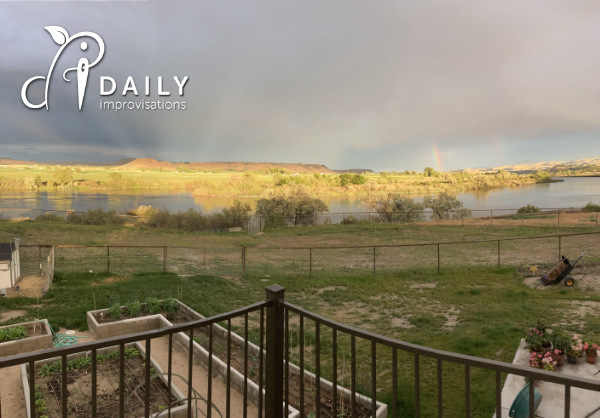There is no mulch like the present – Laura Blodgett
The art of using mulch in your garden or landscape is more free-form than you might think. It depends on
- what is available,
- how you use it, and
- what your climate is.
That may sound like there is some mathematical formula to figure out what to use for mulch and how, but it really often comes down to the moment. One of my recent moments involved discovering ChipDrop.com.
It sounds like a gardener’s dream come true, and it may be in many ways, but after using it, I have some things that should help you evaluate if you want to try it and how you might be better prepared to use it.

Let’s talk about the con’s first:
I will elaborate on each of these after the list.
- You won’t know for sure when it is going to show up
- You won’t know for sure how much you are getting
- You won’t know what kind of trees it comes from ahead of time
- It is non-uniform
- It is green
- It can be difficult to shovel
You won’t know for sure when it is going to show up
When you sign up on the website, they say it usually takes 1-5 weeks for a delivery. That is a long window of time. You can mediate that inconvenience by ordering sooner and getting chips before the gardening season begins in earnest.
Chips are still delivered at the discretion of each arborist and in relation to where they are trimming, but by ordering earlier it is more likely you will have chips to spread when you want them.
To our astonishment, we received our load within 2 days! This doubly surprised us because we are in a very rural location and didn’t figure there was much action out here. It also surprised our son who had to wait quite a bit longer after he signed up.
You won’t know for sure how much you are getting
The size of the load depends on the size of the truck the arborist has. We ended up only getting about 8 cubic yards of mulch, which is fine with me for a start. However, our son received about 20 cubic yards both times he signed up.
So, you have to have a space large enough to pile the possible largest load. They give guidelines for where to be careful of NOT piling it, which mostly has to do with public roads or driveway access.
If you have a smaller yard, you may want to collaborate with neighbors about where to pile it and how to share it.

You won’t know what kind of trees it comes from ahead of time
The most you can do is say what kind of tree wood you DON’T want. Of course, if you are too picky, you may not get any chips for a very long time. Also, note there is a 25 day limit on the sign up, so if you don’t get your chips in the time period, you will need to re-sign up. Since it is not about who signs up first, this shouldn’t matter.
You will need to do your own homework about which kind of chips are acceptable in your yard. For instance, we won’t accept black walnut tree would because it is known to kill other plants. We also are concerned about woods that my horse and goats might nibble on in landscaping they are near or pass through.
It all depends on what kind of trees are being trimmed near you.
You may be able to find out what kind of wood it is when it arrives, if you are home when it is deposited. Unfortunately, the system cannot accommodate scheduling drop-offs. It is supposed to make work easier for the arborists, after all.
I don’t know if it is normal, but the fellow who dropped off at our place called first, which was very nice. He was just letting us know it would be that day. Since we have a flexible schedule, we were able to meet him and ask about the mulch composition. Ours was elm and poplar trees.
It is non-uniform
I was surprised by the different sizes of wood in the load we received. Most of it was smaller, but there were enough chunks and long thin branches or strips of bark to make me wonder about spreading it.
In the end, most of what I have spread so far has spread decently in spite of such pieces, though I have made a little side pile of pieces that I didn’t want to spread.
It partly depends on the look you are hoping for and partly on your patience in dealing with it.
It is green
By this I mean that it is not dried. It was just growing a few hours ago. And there were leaves mixed in with the load we got. Not a huge amount, but enough that there were a few leaves in every shovel full. (More about what I really mean by shovel full later)
Being green means that the mulch is heavier than dry mulch. And it will mold. I found mold growing in my pile within 2-3 inches of the apparently dry surface after just 2 days.
I just made sure I was upwind while putting it in the wheelbarrow. I also tried to get mulch from the pile in ways that would expose more of it to the air until I could get to spreading it again.
Then it rained buckets yesterday, so I expect the pile to be a bit smoldery when the sun comes out warmer in a couple of days.
I used the top, drier layer of the pile for the front landscaping, the areas people see from the road. I will use the moldiest parts in the farthest back parts of the yard AND I will make an effort to spread it out to only 1-2 inches so that it can dry more thoroughly.

It can be difficult to shovel
I have become an expert on shoveling in the last few weeks. I have shoveled out trailers full of garden grade dirt, helped my husband unload lots of road mix for making cement, building patios and repairing the driveway. I have shoveled plain sand then transferred it in a wheel barrow down a slope. I have shoveled composted and fresh horse manure for garden beds and spreading on the pasture.
I have shoveled.
I thought shoveling the wood chip mulch would be comparatively easy. Maybe it is, but it is still harder than I expected.
First, the variety of debris is tangled. Neither a regular spade shovel nor my horse manure shovel worked well. I made progress, but I was putting out a lot of energy trying to get the mulch onto the shovel. I often resorted to scooping it on with my gloved hand.
I then tried a spading fork. (this link is not to the exact spading fork I have.) The spading fork definitely picked up the tangled blobs better, but not much of the other chips. Very slow going. I love my spading fork for weeding, but not for this. I imagine a hay fork would be worse, having tines even farther apart than the spading fork.
The next time I got out my plastic manure fork. (this link is not to the exact manure fork I have.) This was by far the best tool. It poked into the tangled blobs, but also held a lot of smaller chips on top of that. I did end up breaking one plastic tine, but it was till worth it. That is the tool I will be using from now on.
The pro’s of chip drop
- It is free
- It is delivered
- It comes in bulk
- It is all natural
It is free
This is obviously a biggy. It really makes up for a lot of the con’s I mentioned.
It is delivered and it comes in bulk
Even if you do have a truck or trailer, almost none of us average gardeners have a truck that can haul 8 – 20 cubic yards at a time. It is definitely a time saver to have it delivered. It is worth it to figure out a location to accommodate it.
It is all natural
I am not convinced of many of the claims of the hyper-organic crowd, however, I do like mulch that will naturally mix with and biodegrade in the soil. I don’t want weed barrier fabric that ends up being a constant hassle. I also don’t want rocks that are hard to clean up around and that I don’t want mixed with the soil.
One question that seems unanswerable is knowing what the tree’s owner may have sprayed on it for pests or disease. If you are super concerned about this, you may want to skip chip drop.

For the record, I have no association with ChipDrop.com other than signing up for it and receiving a load. I think it was a great idea and am grateful to the person who set it up!
